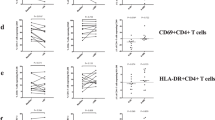Abstract
Background
Vaginal epithelial abnormalities (VEA) are a common complication associated with pessary use. The objective of this study was to determine if there is a host pro-inflammatory response associated with pessary use and VEA.
Methods
Patients wearing pessaries for at least two weeks for the management of pelvic organ prolapse and/or urinary incontinence were screened for eligibility. Vaginal swabs were collected from women with VEA (cases) and without VEA (controls). Cases were matched to controls in a 1:3 ratio. Cytokine analysis of the collected samples was performed using multiplex analysis to determine the concentrations of interleukin (IL)6, interferon alpha 2 (IFNα2), tumor necrosis factor alpha (TNFα) and IL1β. A cross-sectional analysis was performed, comparing vaginal cytokine concentrations in women with and without VEA.
Results
We enrolled 211 patients in this analysis: 50 cases and 161 controls. The median concentrations (pg/mL) of the four cytokines for cases and controls respectively were; IL6: 6.7 (IQR <2.9 [the lower limit of detection, LLD]-14.2) and < 2.9 (LLD) (IQR <2.9 [LLD]-5.5), IFNα2: 8.2 (IQR 6.1–13.9) and 7.9 (IQR 3.9–13.6), TNFα: 15.2 (IQR 6.1–30.4) and 4.68 (IQR <2.3 [LLD]-16.3), IL1β 195.7 (IQR 54.5–388.6) and 38.5 (IQR 6.7–154.9). The differences in median cytokine levels were statistically higher in cases for IL6, TNFα, and IL1β (all p < 0.001) compared to controls. Older age (OR: 1.062, 95% CI, 1.015–1.112), lower BMI (OR: 0.910, 95% CI, 0.839–0.986) and presence of VEA at last check (OR: 5.377, 95% CI, 2.049–14.108) were associated with higher odds of having VEA on multivariate analysis.
Conclusion
Pro-inflammatory cytokines, specifically IL6, TNFα, and IL1β, are elevated in pessary-wearing patients who have VEA. Additional prospective studies are needed to assess baseline vaginal inflammatory profiles before and after pessary placement to understand VEA formation in pessary patients.


Similar content being viewed by others
References
Pott-Grinstein E, Newcomer JR. Gynecologists’ patterns of prescribing pessaries. J Reprod Med. 2001;46(3):205–8.
Cundiff GW, Amundsen CL, Bent AE, et al. The PESSRI study: symptom relief outcomes of a randomized crossover trial of the ring and Gellhorn pessaries. Am J Obstet Gynecol. 2007;196(4):1–8.
Hanson LAM, Schulz JA, Flood CG, Cooley B, Tam F. Vaginal pessaries in managing women with pelvic organ prolapse and urinary incontinence: patient characteristics and factors contributing to success. Int Urogynecol J. 2006;17(2):155–9.
Yimphong T, Temtanakitpaisan T, Buppasiri P, Chongsomchai C, Kanchaiyaphum S. Discontinuation rate and adverse events after 1 year of vaginal pessary use in women with pelvic organ prolapse. Int Urogynecol J. 2018;29(8):1123–8.
Abdulaziz M, Stothers L, Lazare D. An integrative review and severity classification of complications related to pessary use in the treatment of female pelvic organ prolapse. Can Urol Assoc J. 2015;9:E400–6.
Tenfelde S, Tell D, Thomas T, Kenton K. Quality of life in women who use pessaries for longer than 12 months. Female Pelvic Med Reconstr Surg. 2015;21(3):146–9.
Ramsay S, Tu LM, Tannenbaum C. Natural history of pessary use in women aged 65–74 versus 75 years and older with pelvic organ prolapse: a 12-year study. Int Urogynecol J Pelvic Floor Dysfunct. 2016;27(8):1201–7.
Robert M, Schulz JA, Harvey MA, et al. Technical update on pessary use. J Obstet Gynaecol Canada. 2013;35(7):664–74.
Anderson JM, Rodriguez A, Chang DT. Foreign body reaction to biomaterials. Semin Immunol. 2008;20(2):86–100.
Sheikh Z, Brooks PJ, Barzilay O, Fine N, Glogauer M. Macrophages, Foreign Body Giant Cells and Their Response to Implantable Biomaterials. Mater (Basel, Switzerland). 2015;8(9):5671–5701.
Brown BN, Haschak MJ, Lopresti ST, Stahl EC. Effects of age-related shifts in cellular function and local microenvironment upon the innate immune response to implants. Semin Immunol. 2017;29:24–32.
Nolfi AL, Brown BN, Liang R, et al. Host response to synthetic mesh in women with mesh complications. Am J Obstet Gynecol. 2016;215(2):206.e1–8.
Sharma P, Shahabi K, Spitzer R, Farrugia M, Kaul R, Yudin. Cervico-vaginal inflammatory cytokine alterations after intrauterine contraceptive device insertion: A pilot study. PLoS ONE. 2018;13(12):e0207266.
Propst K, Mellen C, Sullivan DMO, Tulikangas PK. Timing of office-based pessary care. Obstet Gynecol. 2020;135(1):100–5.
Leng S. McElhaneyJE, Walston JD, Xie D, Fedarko NS, Kuchel G. ELISA and multiplex technologies for cytokine measurement in inflammation and aging reseaearch. A Biol Sci Med Sci. 2008;63(8):879–84.
Abbas AK, Lichtman AH, Pillai S. Cellular and Molecular Immunology. 9th ed. Philadelphia: Elseiver; 2018.
Jelovsek EJ, Maher C, Barber MD. Pelvic organ prolapse. Lancet. 2007;369:1027–38.
Dessie SG, Armstrong K, Modest AM, Hacker M. Effect of vaginal estrogen on pessary use. Int Urogynecol J Pelvic Floor Dysfunct. 2016;71(9):1423–9.
Collins S, Beigi R, Mellen C, Sullivan DO, Tulikangas P. The effect of pessaries on the vaginal microenvironment. Am J Obstet Gynecol. 2017;212(1):60.e1–60.e6.
Financial support
Hartford Hospital Medical Staff Research Grant.
Presented as short oral presentation at 2019 AUGS/IUGA joint meeting. Nashville, TN.
Author information
Authors and Affiliations
Contributions
AS Ramaseshan: Project development, sample collection and processing, data collection, manuscript writing.
C Mellen: Patient recruitment and sample collection.
DM O’Sullivan: Statistical support and manuscript writing.
C Nold: Project development, sample processing and manuscript writing.
PK Tulikangas: Project development and manuscript writing.
Corresponding author
Ethics declarations
Conflict of interests
The authors report no conflict of interests or financial disclosures.
Additional information
Publisher’s note
Springer Nature remains neutral with regard to jurisdictional claims in published maps and institutional affiliations.
Rights and permissions
About this article
Cite this article
Ramaseshan, A.S., Mellen, C., O’Sullivan, D.M. et al. Host inflammatory response in women with vaginal epithelial abnormalities after pessary use. Int Urogynecol J 33, 2151–2157 (2022). https://doi.org/10.1007/s00192-021-05001-8
Received:
Accepted:
Published:
Issue Date:
DOI: https://doi.org/10.1007/s00192-021-05001-8




